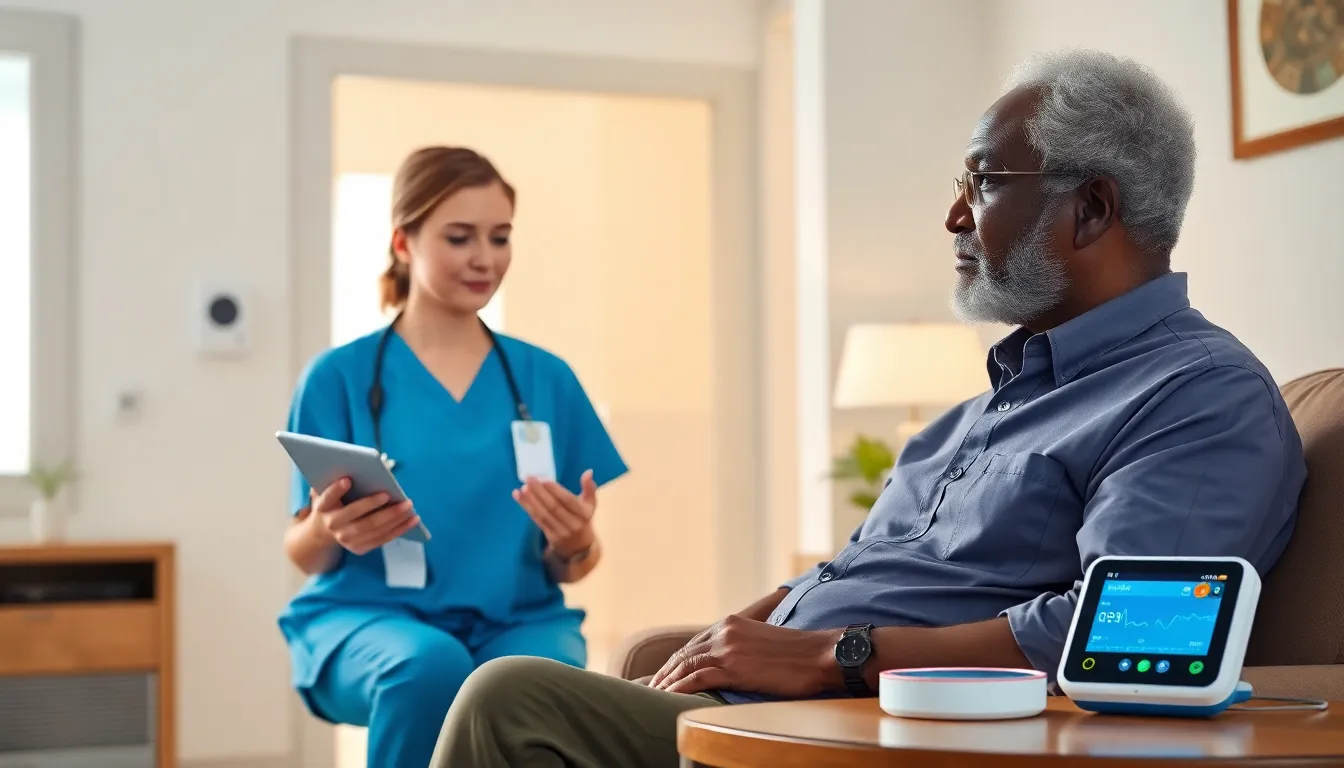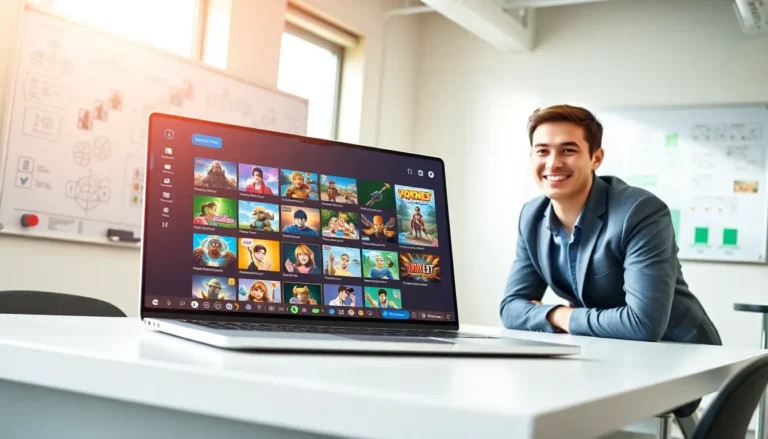Table of Contents
ToggleIn a world where “out of sight, out of mind” no longer applies, remote monitoring is the superhero we didn’t know we needed. Imagine being able to keep an eye on your home, health, or business from anywhere—yes, even from that cozy spot on your couch where snacks are just an arm’s reach away. It’s like having a trusty sidekick, minus the cape and questionable fashion choices.
Overview Of Remote Monitoring
Remote monitoring represents a transformative approach to managing various elements of daily life. This technology allows individuals and organizations to track conditions and performance from a distance. Health care providers leverage remote monitoring to monitor patient vitals such as heart rate and blood pressure, ensuring timely interventions.
Businesses utilize remote monitoring systems to oversee equipment and processes in real time. They maintain operational efficiency through alerts on equipment failures or irregularities. Homeowners benefit from smart devices that enable surveillance of home security systems, energy usage, and environmental conditions.
Financial institutions also employ remote monitoring for fraud detection. They analyze transaction patterns to identify anomalies instantly. Education sectors integrate remote monitoring tools to enhance student engagement and performance tracking.
Cloud technologies often support remote monitoring solutions by providing secure data storage and analytics. Users access metrics and alerts through user-friendly interfaces, promoting faster decision-making. The integration of artificial intelligence with remote monitoring streamlines data analysis, identifying trends or potential issues quickly.
Industries prioritizing safety and compliance rely heavily on remote monitoring systems. They track environmental conditions, ensuring adherence to regulations. Remote monitoring generates substantial savings, reduces downtime, and improves service quality across various sectors.
Incorporating remote monitoring into daily operations has become essential for effective management. Many individuals and organizations utilize these systems to enhance their operational capabilities, leading to improved outcomes and peace of mind.
Benefits Of Remote Monitoring

Remote monitoring presents numerous advantages across various sectors. Its impact on healthcare and cost management exemplifies its effectiveness.
Improved Patient Care
Healthcare providers significantly enhance patient care through remote monitoring technologies. Patients receive real-time health updates, allowing for immediate interventions when necessary. Monitoring chronic conditions remotely reduces hospitalization rates and promotes proactive management. Physicians access vital data quickly, enabling tailored treatment plans based on individual needs. This continuous oversight ensures that patients feel supported, fostering a stronger patient-provider relationship.
Cost Efficiency
Remote monitoring delivers substantial cost savings across industries. Businesses optimize operations by reducing on-site staff requirements, decreasing labor costs. Organizations avoid costly downtimes by identifying equipment issues before they escalate into major failures. Healthcare systems minimize expenses related to emergency interventions through regular patient monitoring. Even households save money with smart technology that optimizes energy usage and security. Overall, remote monitoring facilitates a more efficient allocation of resources, leading to significant long-term savings.
Technologies Used In Remote Monitoring
Remote monitoring relies on various technologies that enhance its effectiveness and reach. Key components include wearable devices and mobile applications that provide real-time data collection and communication.
Wearable Devices
Wearable devices play a significant role in remote monitoring, particularly in healthcare. These gadgets, such as smartwatches and fitness trackers, continuously gather data on vital signs like heart rate, blood pressure, and activity levels. Medical professionals access this information to assess patient health remotely. They can detect irregularities and intervene faster when necessary. For instance, devices equipped with ECG monitoring alert both users and healthcare providers to any concerning arrhythmias. Many wearables also facilitate medication reminders, improving adherence to treatment plans. Consequently, these devices contribute to better health outcomes and greater patient engagement.
Mobile Applications
Mobile applications enhance remote monitoring by enabling users to access data anywhere and anytime. These apps allow users to track health metrics, receive alerts, and communicate with healthcare providers effortlessly. Integration with wearable devices offers seamless data synchronization, creating a comprehensive health profile. Users can visualize trends through user-friendly interfaces, aiding in self-management of conditions like diabetes or hypertension. For businesses, applications monitor equipment performance and environmental conditions in real time. They alert users about potential malfunctions or safety issues, thereby enhancing operational efficiency. Overall, mobile apps are essential for enhancing the convenience of remote monitoring across various sectors.
Challenges In Implementing Remote Monitoring
Implementing remote monitoring systems presents several challenges that organizations must navigate effectively.
Data Security Concerns
Data security remains a primary concern in remote monitoring. Organizations collect sensitive information, including health metrics and operational data. Cyber attacks pose significant risks, as unauthorized access can lead to data breaches and jeopardize patient or customer trust. Ensuring compliance with regulations, like HIPAA and GDPR, adds another layer of complexity. Organizations must prioritize robust encryption and security protocols to safeguard this data. Regular security audits can help identify vulnerabilities. Training personnel on cybersecurity practices further mitigates risks associated with remote monitoring.
Integration With Existing Systems
Integration with existing systems poses another substantial challenge. Many organizations rely on legacy systems that may not support modern remote monitoring technologies. Seamless communication between these systems often proves difficult. Ensuring compatibility requires careful planning and may involve updating or replacing outdated software. Organizations should assess their current infrastructure and identify integration options. Engaging IT specialists can facilitate this process, ensuring a smoother transition. Developing a clear roadmap for implementation fosters a cohesive approach across all departments.
Future Trends In Remote Monitoring
Emerging trends in remote monitoring indicate significant advancements in various areas. Continued growth in technology will enhance capabilities and expand applications.
Artificial Intelligence And Machine Learning
Artificial intelligence and machine learning play crucial roles in shaping remote monitoring. By analyzing vast amounts of data efficiently, these technologies identify patterns that human analysts might miss. Predictive analytics powered by AI forecast trends and potential health issues, allowing for better decision-making. For instance, platforms utilizing machine learning can personalize health recommendations based on real-time data from wearables. Extensive data sets lead to quicker diagnoses and improved patient outcomes. AI-driven chatbots can offer immediate responses to patient questions, enhancing user engagement and support.
Expansion In Home Healthcare
The expansion of home healthcare represents a vital area of growth within remote monitoring. Increased access to home health devices enables patients to receive care in their familiar environments. Such devices continuously track vital signs and communicate health data to providers, fostering timely interventions. Individuals with chronic conditions benefit from this innovation, as it minimizes hospital visits and enhances their quality of life. Demand for telehealth services has surged, connecting patients with healthcare professionals conveniently. This shift toward home-based care reflects rising preferences for personalized, accessible healthcare solutions.
Remote monitoring has become an indispensable part of modern life. Its ability to provide real-time insights across various sectors enhances efficiency and promotes better decision-making. As technology continues to evolve, the integration of AI and machine learning will further refine remote monitoring capabilities, enabling predictive analytics and improved patient care.
The challenges of data security and system integration highlight the need for careful planning and robust strategies. However, the benefits—ranging from cost savings to enhanced safety—far outweigh these hurdles. Embracing remote monitoring not only streamlines operations but also fosters a proactive approach to health and safety in everyday life.





